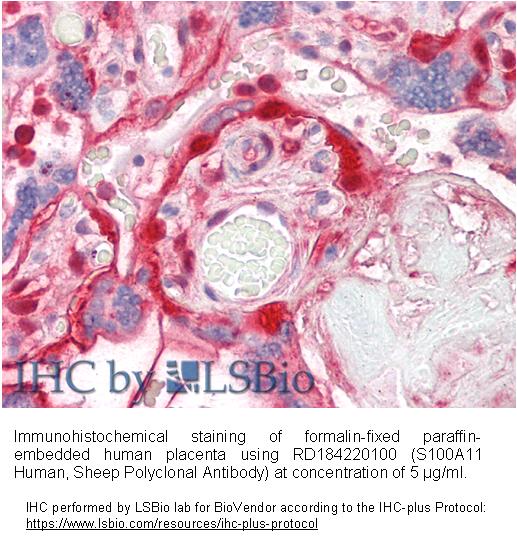Type
Polyclonal Antibody
Applications
Western blotting, ELISA, Immunohistochemistry
Antibodies Applications
Source of Antigen
E. coli
Hosts
Sheep
Preparation
The antibody was raised in sheep by immunization with the recombinant Human S100-A11.
Amino Acid Sequence
The immunization antigen (12.98 kDa) is a protein containing 115 AA of recombinant Human S100-A11. N-Terminal His-tag, 10 extra AA.
MKHHHHHHASMAKISSPTETERCIESLIAVFQKYAGKDGYNYTLSKTEFLSFMNTELAAFTKNQKDPGVLDRMMKKLDTNSDGQLDFSEFLNLIGGLAMACHDSFLKAVPSQKRT
Species Reactivity
Human. Not yet tested in other species.
Purification Method
Immunoaffinity chromatography on a column with immobilized recombinant Human S100-A11.
Antibody Content
0.1 mg (determined by BCA method, BSA was used as a standard)
Formulation
The antibody is lyophilized in 0.05 M phosphate buffer, 0.1 M NaCl, pH 7.2.
Reconstitution
Add 0.2 ml of deionized water and let the lyophilized pellet dissolve completely. Slight turbidity may occur after reconstitution, which does not affect activity of the antibody. In this case clarify the solution by centrifugation.
Shipping
At ambient temperature. Upon receipt, store the product at the temperature recommended below.
Storage/Expiration
The lyophilized antibody remains stable and fully active until the expiry date when stored at -20°C. Aliquot the product after reconstitution to avoid repeated freezing/thawing cycles and store frozen at -80°C. Reconstituted antibody can be stored at 4°C for a limited period of time; it does not show decline in activity after one week at 4°C.
Quality Control Test
SDS PAGE - to determine purity of the antibody
BCA - to determine quantity of the antibody
Note
This product is for research use only.
Research topic
Cardiovascular disease, Immune Response, Infection and Inflammation, Oncology, Others
Summary
S100A11 (S100C; calgizzarin) was first isolated from chicken gizzard smooth muscle. Human homologue was later identified in human colorectal cancer cells and in colorectal normal mucosa, with much higher expression in the cancer cells. S100A11 is a member of the S100 family of proteins containing 2 EF-hand calcium-binding motifs. The polypeptide chain consists of 105 amino acid residues giving molecular weight of unmodified monomeric protein 11.74 kDa. Disulphide bridge linking two monomers in the dimer via Cys-11 residues was found in its structure. The protein can be phosphorylated on some residues from which at least phosphorylation on Thr-10 causes significant structural changes. S100A11 binds to annexins A1 and A2, the DNA-dependent ATPase Rad54B, p53 and RAGE. It was proposed that up-regulated chondrocyte expression of S100A11 (as RAGE ligand) in OA cartilage and RAGE signaling through the p38 MAPK pathway promote inflammation-associated chondrocyte hypertrophy. RAGE signaling mediated by S100A11 thereby might have the potential to contribute to the progression of OA. S100A11 has also been shown to be secreted and to exert RAGE dependent signaling in human keratinocytes. S100A11 was found in many different human both normal and cancer tissues. S100A11 appears to play distinct roles depending on the tumour involved. In bladder carcinoma or renal carcinoma expression is related to tumour suppression however in prostate cancer, breast and pancreatic cancer S100A11 is thought to be a tumour promoter. S100A11 has been also indicated as one of potential biomarkers of infective endocarditis.


